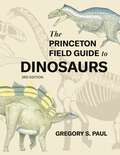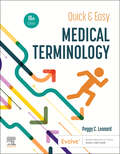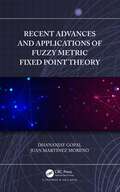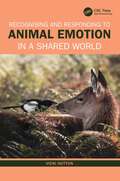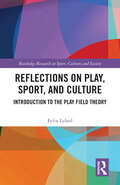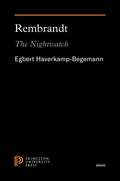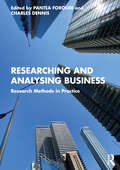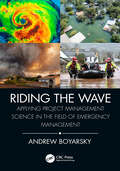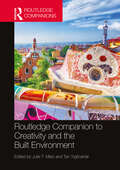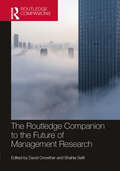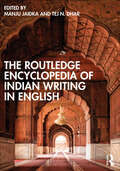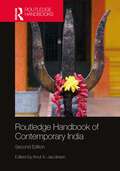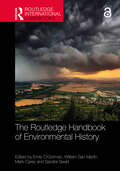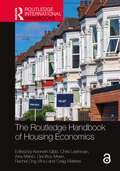- Table View
- List View
The Princeton Field Guide to Dinosaurs Third Edition (Princeton Field Guides #69)
by Gregory S. PaulA fully updated and expanded edition of the acclaimed, bestselling dinosaur field guideThe bestselling Princeton Field Guide to Dinosaurs remains the must-have book for anyone who loves dinosaurs, from amateur enthusiasts to professional paleontologists. Now extensively revised and expanded, this dazzlingly illustrated large-format edition features nearly 100 new dinosaur species and hundreds of new and updated illustrations, bringing readers up to the minute on the latest discoveries and research that are radically transforming what we know about dinosaurs and their world.Written and illustrated by acclaimed dinosaur expert Gregory Paul, this stunningly beautiful book includes detailed species accounts of all the major dinosaur groups as well as a wealth of breathtaking images—skeletal drawings, &“life&” studies, scenic views, and other illustrations that depict the full range of dinosaurs, from small feathered creatures to whale-sized supersauropods. Paul&’s extensive introduction delves into dinosaur history and biology, the extinction of nonavian dinosaurs, the origin of birds, and the history of dinosaur paleontology, and also gives a taste of what it might be like to travel back in time to the era when dinosaurs roamed the earth.Now covers more than 800 dinosaur species, including scores of newly discovered onesProvides startling perspectives on the famed Brontosaurus and TyrannosaurusReveals that the largest dinosaurs weighed as much as the biggest whales, and shows why that happenedFeatures hundreds of color and black-and-white drawings and figures, including life studies, scenic views, and skull and muscle drawingsIncludes color paleo-distribution maps and a color time lineDescribes anatomy, physiology, locomotion, reproduction, and growth of dinosaurs, as well as the origin of birds and the extinction of nonavian dinosaurs
Quick & Easy Medical Terminology - E-Book: Quick & Easy Medical Terminology - E-Book
by Peggy C. LeonardLearn to read, write, and speak in medical terms in no time! Ideal for one-semester courses and self-study, Quick & Easy Medical Terminology, 10th Edition covers disorders, diagnosis, and treatment with a strong focus on anatomy. This clear, concise text presents small bits of information, followed immediately by a test for comprehension, using a combination of programmed and traditional review questions. This edition includes additional health care reports and review exercises, as well as new and updated terminology, images, and illustrations. With help from resources on the companion Evolve website, Quick & Easy Medical Terminology provides simple tools you need for good communication in the health care environment. Programmed learning approach improves comprehension by offering immediate feedback. Focus on basic word-building skills enables quick and easy learning, making this text perfect for shorter, one- or two-credit medical terminology courses or self-study. Integrated review exercises provide frequent tests of knowledge and retention of material. Quick Tips located throughout the text provide fun facts and memory aids. Evolve Student Resources include games, activities, animations, pharmacology, and audio terms, all of which offer a wealth of additional opportunities to quickly gauge areas of strength and weakness in a fun and interactive environment. NEW! Additional health care reports with review exercises facilitate the study of terminology in documents like those seen in the clinical setting. NEW and UPDATED! Terms, definitions, and procedures keep you up to date with the latest terminology and healthcare advances. NEW and UPDATED! Professional photos and detailed body system illustrations clearly and consistently reinforce complex terms and procedures.
Recent Advances and Applications of Fuzzy Metric Fixed Point Theory
by Dhananjay Gopal Juan Martinez MorenoThis book not only presents essential material to understand fuzzy metric fixed point theory, but also enables the readers to appreciate the recent advancements made in this direction. It contains seven chapters on different topics in fuzzy metric fixed point theory. These chapters cover a good range of interesting topics such as con- vergence problems in fuzzy metrics, fixed figure problems, and applications of fuzzy metrics. The main focus is to unpack a number of diverse aspects of fuzzy metric fixed point theory and its applications in an understandable way so that it could help and motivate young graduates to explore new avenues of research to extend this flourishing area in different directions. The discussion on fixed figure problems and fuzzy contractive fixed point theorems and their different generalizations invites active researchers in this field to develop a new branch of fixed point theory. Features: Explore the latest research and developments in fuzzy metric fixed point theory. Describes applications of fuzzy metrics to colour image processing. Covers new topics on fuzzy fixed figure problems. Filled with examples and open problems. This book serves as a reference book for scientific investigators who want to analyze a simple and direct presentation of the fundamentals of the theory of fuzzy metric fixed point and its applications. It may also be used as a textbook for postgraduate and research students who try to derive future research scope in this area.
Recent Advances and Applications of Fuzzy Metric Fixed Point Theory
by Dhananjay Gopal Juan Martinez MorenoThis book not only presents essential material to understand fuzzy metric fixed point theory, but also enables the readers to appreciate the recent advancements made in this direction. It contains seven chapters on different topics in fuzzy metric fixed point theory. These chapters cover a good range of interesting topics such as con- vergence problems in fuzzy metrics, fixed figure problems, and applications of fuzzy metrics. The main focus is to unpack a number of diverse aspects of fuzzy metric fixed point theory and its applications in an understandable way so that it could help and motivate young graduates to explore new avenues of research to extend this flourishing area in different directions. The discussion on fixed figure problems and fuzzy contractive fixed point theorems and their different generalizations invites active researchers in this field to develop a new branch of fixed point theory. Features: Explore the latest research and developments in fuzzy metric fixed point theory. Describes applications of fuzzy metrics to colour image processing. Covers new topics on fuzzy fixed figure problems. Filled with examples and open problems. This book serves as a reference book for scientific investigators who want to analyze a simple and direct presentation of the fundamentals of the theory of fuzzy metric fixed point and its applications. It may also be used as a textbook for postgraduate and research students who try to derive future research scope in this area.
Recognising and Responding to Animal Emotion in a Shared World
by Vicki HuttonHow is it that depending on the setting, the same cat can be perceived as a homeless annoyance, a potential research subject or a thinking and feeling family member? The answer is bound up in our perception of non-human animals’ capacity to experience emotions, and this book draws on contemporary evidence-based research, observations, interviews and anecdotal case scenarios to explore the growing knowledge base around animal emotion. Acknowledging that animals can experience feelings directly affects the way that they are perceived and treated in many settings, and the author explores the implications when humans apply – or ignore – this knowledge selectively between species and within species. This information is presented within the unique context of a proposed hierarchy of perceived non-human animals' emotional abilities (often based on human interpretation of the animal’s emotional capacity), with examples of how this manifests at an emotional, spiritual and moral level. Implications for specific groups living with, caring for or working with non-human animals are examined, making the book of particular interest to those working, studying or researching in the veterinary professions; animal ethics, law and welfare; and zoology, biology and animal science. This book will also be fascinating reading for anyone interested in simply learning more about the animals with whom we share this planet. For some readers, it will validate the reciprocal emotional bond they feel for living creatures. For others, it will raise questions about the moral treatment of sentient non-human beings, breaking down the human protective barrier of cognitive dissonance and activating a cycle of change.
Recognising and Responding to Animal Emotion in a Shared World
by Vicki HuttonHow is it that depending on the setting, the same cat can be perceived as a homeless annoyance, a potential research subject or a thinking and feeling family member? The answer is bound up in our perception of non-human animals’ capacity to experience emotions, and this book draws on contemporary evidence-based research, observations, interviews and anecdotal case scenarios to explore the growing knowledge base around animal emotion. Acknowledging that animals can experience feelings directly affects the way that they are perceived and treated in many settings, and the author explores the implications when humans apply – or ignore – this knowledge selectively between species and within species. This information is presented within the unique context of a proposed hierarchy of perceived non-human animals' emotional abilities (often based on human interpretation of the animal’s emotional capacity), with examples of how this manifests at an emotional, spiritual and moral level. Implications for specific groups living with, caring for or working with non-human animals are examined, making the book of particular interest to those working, studying or researching in the veterinary professions; animal ethics, law and welfare; and zoology, biology and animal science. This book will also be fascinating reading for anyone interested in simply learning more about the animals with whom we share this planet. For some readers, it will validate the reciprocal emotional bond they feel for living creatures. For others, it will raise questions about the moral treatment of sentient non-human beings, breaking down the human protective barrier of cognitive dissonance and activating a cycle of change.
Reflections on Play, Sport, and Culture: Introduction to the Play Field Theory (Routledge Research in Sport, Culture and Society #141)
by Felix LebedThe psychological dependence of humanity on playing is huge. Its nature and functional utility are unclear. These linked yet contradictory issues have created the intrigue that has fed philosophical thought for more than two hundred years. During this period, philosophy transferred many of the subjects of its analysis to the aegis of the humanities that it spawned. Each of them pays close attention to human play and studies it with its own methods of theoretical and experimental research. Thus, what was once a general philosophical comprehension of human play has branched out into different directions, definitions, and theories. This new book represents a renewed general view of human play. The unique quality of the volume lies in its fairly rare interdisciplinary methodology, encompassing a broad spectrum of the humanities: philosophy, anthropology, sociology, and the history of play, and behavioral analysis of playing, which have been done by the author. As a result, the volume ends with the proposition of a new general approach to human play that is named by the author “play field theory”. Such an approach makes reflections on play, sport, and culture a source for all scholars studying play, by widening their knowledge through both a new general view and their familiarization with notions from neighboring fields and disciplines.
Reflections on Play, Sport, and Culture: Introduction to the Play Field Theory (Routledge Research in Sport, Culture and Society #141)
by Felix LebedThe psychological dependence of humanity on playing is huge. Its nature and functional utility are unclear. These linked yet contradictory issues have created the intrigue that has fed philosophical thought for more than two hundred years. During this period, philosophy transferred many of the subjects of its analysis to the aegis of the humanities that it spawned. Each of them pays close attention to human play and studies it with its own methods of theoretical and experimental research. Thus, what was once a general philosophical comprehension of human play has branched out into different directions, definitions, and theories. This new book represents a renewed general view of human play. The unique quality of the volume lies in its fairly rare interdisciplinary methodology, encompassing a broad spectrum of the humanities: philosophy, anthropology, sociology, and the history of play, and behavioral analysis of playing, which have been done by the author. As a result, the volume ends with the proposition of a new general approach to human play that is named by the author “play field theory”. Such an approach makes reflections on play, sport, and culture a source for all scholars studying play, by widening their knowledge through both a new general view and their familiarization with notions from neighboring fields and disciplines.
Rembrandt: The Nightwatch
by Egbert Haverkamp-BegemannA landmark book that casts critical light on one of Rembrandt&’s most iconic paintingsIn The Nightwatch, Rembrandt turns his portrayal of eighteen prominent Amsterdam citizens as members of a militia company into one of the world&’s most fascinating works of art, one that evokes censure as well as praise. The painting, however, was not an eccentric vision but a thoughtful reworking of a longstanding tradition of militia portraiture. In this classic book, Egbert Haverkamp-Begemann shows how Rembrandt chose motifs, colors, actions, and setting to emphasize the historic role of the militia in Amsterdam and the social standing of the men portrayed, and how contemporary viewers associated costumes and actions with events of the past and familiar circumstances of the period when the painting was made. Meticulously reconstructing the artist&’s intentions and the viewer&’s response, Haverkamp-Begemann sheds critical light on the startling young woman in gold and other visual elements of this remarkable work.
Researching and Analysing Business: Research Methods in Practice
Researching and Analysing Business: Research Methods in Practice provides an accessible and practical guide to various data collection and data analysis techniques within management, from both quantitative and qualitative perspectives. This key resource functions as a comprehensive reference tool – covering a broad variety of methodologies – examining both the theory behind them and their application in practice. These include systematic literature review through bibliometric and meta-analysis, secondary vs primary sources, qualitative research vs quantitative research, combining qualitative and quantitative methods, qualitative and quantitative research method approaches, fsQCA, data mining, and sentiment analysis. Chapters are rich in examples, data sets, practical exercises, easy-to-follow slides, and a glossary, which help readers to understand and apply research approaches as well as to assess the strengths and weaknesses of each method. Unique in its practical approach and with insights from active researchers, this book is required and recommended reading for advanced undergraduate and postgraduate students studying research methods as a core module within business and management courses. It is also a useful tool for PhD students and academics within the discipline. Online support materials include PowerPoint slides.
Researching and Analysing Business: Research Methods in Practice
by Pantea Foroudi Charles DennisResearching and Analysing Business: Research Methods in Practice provides an accessible and practical guide to various data collection and data analysis techniques within management, from both quantitative and qualitative perspectives. This key resource functions as a comprehensive reference tool – covering a broad variety of methodologies – examining both the theory behind them and their application in practice. These include systematic literature review through bibliometric and meta-analysis, secondary vs primary sources, qualitative research vs quantitative research, combining qualitative and quantitative methods, qualitative and quantitative research method approaches, fsQCA, data mining, and sentiment analysis. Chapters are rich in examples, data sets, practical exercises, easy-to-follow slides, and a glossary, which help readers to understand and apply research approaches as well as to assess the strengths and weaknesses of each method. Unique in its practical approach and with insights from active researchers, this book is required and recommended reading for advanced undergraduate and postgraduate students studying research methods as a core module within business and management courses. It is also a useful tool for PhD students and academics within the discipline. Online support materials include PowerPoint slides.
Riding the Wave: Applying Project Management Science in the Field of Emergency Management (ISSN)
by Andrew BoyarskyEmergency managers and public safety professionals are more frequently being called on to address increasingly challenging and complex critical incidents, with a wider variety and intensity of hazards, threats, and community vulnerabilities. Much of the work that falls into the scope of emergency managers – prevention, preparedness, mitigation – is “blue sky planning” and can be contained and effectively managed within projects. This book provides a foundational project management methodology relevant to emergency management practice, and explains and demonstrates how project management can be applied in the context of emergency and public safety organizations.Special features include: an initial focus on risk assessment and identification of mitigation and response planning measures; a clear set of better practices, using a diverse set of examples relevant to today’s emergency environment, from projects to develop emergency response exercises to application development to hazard mitigation; a framework for managing projects at a strategic level and how to incorporate this into an organization’s program, and presents how to develop and manage an emergency program and project portfolio; and suitability as both a hands-on training guide for emergency management programs and a textbook for academic emergency management programs. This book is intended for emergency managers and public safety professionals who are responsible for developing emergency programs and plans, including training courses, job aids, computer applications and new technology, developing exercises, and for implementing these plans and components in response to an emergency event. This audience includes managers in emergency and first response functions such as fire protection, law enforcement and public safety, emergency medical services, public health and healthcare, sanitation, public works, business continuity managers, crisis managers, and all managers in emergency support functions as described by FEMA. This would include those who have responsibility for emergency management functions, even without the related title.
Riding the Wave: Applying Project Management Science in the Field of Emergency Management (ISSN)
by Andrew BoyarskyEmergency managers and public safety professionals are more frequently being called on to address increasingly challenging and complex critical incidents, with a wider variety and intensity of hazards, threats, and community vulnerabilities. Much of the work that falls into the scope of emergency managers – prevention, preparedness, mitigation – is “blue sky planning” and can be contained and effectively managed within projects. This book provides a foundational project management methodology relevant to emergency management practice, and explains and demonstrates how project management can be applied in the context of emergency and public safety organizations.Special features include: an initial focus on risk assessment and identification of mitigation and response planning measures; a clear set of better practices, using a diverse set of examples relevant to today’s emergency environment, from projects to develop emergency response exercises to application development to hazard mitigation; a framework for managing projects at a strategic level and how to incorporate this into an organization’s program, and presents how to develop and manage an emergency program and project portfolio; and suitability as both a hands-on training guide for emergency management programs and a textbook for academic emergency management programs. This book is intended for emergency managers and public safety professionals who are responsible for developing emergency programs and plans, including training courses, job aids, computer applications and new technology, developing exercises, and for implementing these plans and components in response to an emergency event. This audience includes managers in emergency and first response functions such as fire protection, law enforcement and public safety, emergency medical services, public health and healthcare, sanitation, public works, business continuity managers, crisis managers, and all managers in emergency support functions as described by FEMA. This would include those who have responsibility for emergency management functions, even without the related title.
Routledge Companion to Creativity and the Built Environment (Routledge International Handbooks)
by Julie T. Miao Tan YigitcanlarThis book crtitically examines the reciprocal relationship between creativity and the built environment and features leading voices from across the world in a debate on originating, learning, modifying, and plagiarizing creativities within the built environment.The Companion includes contributions from architecture, design, planning, construction, real estate, economics, urban studies, geography, sociology, and public policies. Contributors review the current field and proposes new conceptual frameworks, research methodologies, and directions for research, policy, and practice. Chapters are organised into five sections, each drawing on cross-disciplinary insights and debates: Section I connects creativity, productivity, and economic growth and examines how our built environment stimulates or intimidates human imaginations. Section II addresses how hard environments are fabricated with social, cultural, and institutional meanings, and how these evolve in different times and settings. Section III discusses activities that directly and indirectly shape the material development of a built environment, its environmental sustainability, space utility, and place identity. Section IV illustrates how technologies and innovations are used in building and strengthening an intelligent, real-time, responsive urban agenda. Section V examines governance opportunities and challenges at the interface between creativity and built environment. An important resource for scholars and students in the fields of urban planning and development, urban studies, environmental sustainability, human geography, sociology, and public policy.
Routledge Companion to Creativity and the Built Environment (Routledge International Handbooks)
This book crtitically examines the reciprocal relationship between creativity and the built environment and features leading voices from across the world in a debate on originating, learning, modifying, and plagiarizing creativities within the built environment.The Companion includes contributions from architecture, design, planning, construction, real estate, economics, urban studies, geography, sociology, and public policies. Contributors review the current field and proposes new conceptual frameworks, research methodologies, and directions for research, policy, and practice. Chapters are organised into five sections, each drawing on cross-disciplinary insights and debates: Section I connects creativity, productivity, and economic growth and examines how our built environment stimulates or intimidates human imaginations. Section II addresses how hard environments are fabricated with social, cultural, and institutional meanings, and how these evolve in different times and settings. Section III discusses activities that directly and indirectly shape the material development of a built environment, its environmental sustainability, space utility, and place identity. Section IV illustrates how technologies and innovations are used in building and strengthening an intelligent, real-time, responsive urban agenda. Section V examines governance opportunities and challenges at the interface between creativity and built environment. An important resource for scholars and students in the fields of urban planning and development, urban studies, environmental sustainability, human geography, sociology, and public policy.
The Routledge Companion to the Future of Management Research (ISSN)
by David Crowther Shahla SeifiThe management of organisations continues to evolve as new priorities emerge and new approaches are developed. Thus, it is clear that research into business and management will also continue to evolve. This will be in terms of both what is researched and in terms of the techniques and methods used to conduct research. Such development will continue into the future and this book highlights evolving areas. It also suggests new topics which are emerging and new techniques to conduct such research – topics and techniques that will be of benefit to researchers. The unique focus on the future of research methods in management, the emergence of topics in contemporary management and sustainability research and practices, such as sustainability and circular economy, will set this volume apart.With coverage of new and emerging subjects in management studies such as sustainability, zero carbon, green market, and circular economy, and the international collaboration with contributors from all around the globe, this major interdisciplinary reference volume will be of interest and great value to researchers, academics, and advanced students in the fields of business and management research and appropriate methodologies.
The Routledge Companion to the Future of Management Research (ISSN)
by David Crowther Shahla SeifiThe management of organisations continues to evolve as new priorities emerge and new approaches are developed. Thus, it is clear that research into business and management will also continue to evolve. This will be in terms of both what is researched and in terms of the techniques and methods used to conduct research. Such development will continue into the future and this book highlights evolving areas. It also suggests new topics which are emerging and new techniques to conduct such research – topics and techniques that will be of benefit to researchers. The unique focus on the future of research methods in management, the emergence of topics in contemporary management and sustainability research and practices, such as sustainability and circular economy, will set this volume apart.With coverage of new and emerging subjects in management studies such as sustainability, zero carbon, green market, and circular economy, and the international collaboration with contributors from all around the globe, this major interdisciplinary reference volume will be of interest and great value to researchers, academics, and advanced students in the fields of business and management research and appropriate methodologies.
The Routledge Encyclopedia of Indian Writing in English
Today, Indian writing in English is a fi eld of study that cannot be overlooked. Whereas at the turn of the 20th century, writers from India who chose to write in English were either unheeded or underrated, with time the literary world has been forced to recognize and accept their contribution to the corpus of world literatures in English. Showcasing the burgeoning field of Indian English writing, this encyclopedia documents the poets, novelists, essayists, and dramatists of Indian origin since the pre-independence era and their dedicated works. Written by internationally recognized scholars, this comprehensive reference book explores the history and development of Indian writers, their major contributions, and the critical reception accorded to them. The Routledge Encyclopedia of Indian Writing in English will be a valuable resource to students, teachers, and academics navigating the vast area of contemporary world literature.
The Routledge Encyclopedia of Indian Writing in English
by Manju Jaidka Tej N. DharToday, Indian writing in English is a fi eld of study that cannot be overlooked. Whereas at the turn of the 20th century, writers from India who chose to write in English were either unheeded or underrated, with time the literary world has been forced to recognize and accept their contribution to the corpus of world literatures in English. Showcasing the burgeoning field of Indian English writing, this encyclopedia documents the poets, novelists, essayists, and dramatists of Indian origin since the pre-independence era and their dedicated works. Written by internationally recognized scholars, this comprehensive reference book explores the history and development of Indian writers, their major contributions, and the critical reception accorded to them. The Routledge Encyclopedia of Indian Writing in English will be a valuable resource to students, teachers, and academics navigating the vast area of contemporary world literature.
Routledge Handbook of Contemporary India
by Knut A. JacobsenThis revised and updated new edition of the Routledge Handbook of Contemporary India concentrates on India as it emerged after the economic reforms and the new economic policy of the 1980s and 1990s and as it develops in the twenty-first century. It presents new developments and advancements in the research literature and includes discussions of the major political change in India since the Hindu nationalist party Bharatiya Janata Party (BJP) came to power in 2014. This Handbook contains chapters by the field’s foremost scholars dealing with fundamental issues in India’s current cultural and social transformation. This new edition also contains six new chapters on topics not covered by the first edition, such as changes caused by the Hindu majoritarian political ideology, the Hinduization process in the northeast of India and contemporary Dalit and Adivasi literatures. Following an introduction by the editor, the book is divided into five parts: Part I: Foundation Part II: India and the world Part III: Society, class, caste and gender Part IV: Religion and diversity Part V: Cultural change and innovations Exploring the cultural changes and innovations relating a number of contexts in contemporary India, this Handbook is essential reading for students and scholars interested in Indian and South Asian culture, politics and society.
Routledge Handbook of Contemporary India
by Knut A. JacobsenThis revised and updated new edition of the Routledge Handbook of Contemporary India concentrates on India as it emerged after the economic reforms and the new economic policy of the 1980s and 1990s and as it develops in the twenty-first century. It presents new developments and advancements in the research literature and includes discussions of the major political change in India since the Hindu nationalist party Bharatiya Janata Party (BJP) came to power in 2014. This Handbook contains chapters by the field’s foremost scholars dealing with fundamental issues in India’s current cultural and social transformation. This new edition also contains six new chapters on topics not covered by the first edition, such as changes caused by the Hindu majoritarian political ideology, the Hinduization process in the northeast of India and contemporary Dalit and Adivasi literatures. Following an introduction by the editor, the book is divided into five parts: Part I: Foundation Part II: India and the world Part III: Society, class, caste and gender Part IV: Religion and diversity Part V: Cultural change and innovations Exploring the cultural changes and innovations relating a number of contexts in contemporary India, this Handbook is essential reading for students and scholars interested in Indian and South Asian culture, politics and society.
The Routledge Handbook of Environmental History (Routledge International Handbooks)
by Emily O’Gorman William San Martín Mark Carey Sandra SwartThe Routledge Handbook of Environmental History presents a cutting-edge overview of the dynamic and ever-expanding field of environmental history. It addresses recent transformations in the field and responses to shifting scholarly, political, and environmental landscapes. The handbook fully and critically engages with recent exciting changes, contextualizes them within longer-term shifts in the field, and charts potential new directions for study. It focuses on five key areas: Theories and concepts related to changing considerations of social justice, including postcolonial, antiracist, and feminist approaches, and the field’s growing emphasis on multiple human voices and agencies. The roles of non-humans and the more-than-human in the telling of environmental histories, from animals and plants to insects as vectors of disease and the influences of water and ice, the changing theoretical approaches and the influence of concepts in related areas such as animal and discard studies. How changes in theories and concepts are shaping methods in environmental history and shifting approaches to traditional sources like archives and oral histories as well as experiments by practitioners with new methods and sources. Responses to a range of current complex problems, such as climate change, and how environmental historians can best help mitigate and resolve these problems. Diverse ways in which environmental historians disseminate their research within and beyond academia, including new modes of research dissemination, teaching, and engagements with stakeholders and the policy arena. This is an important resource for environmental historians, researchers and students in the related fields of political ecology, environmental studies, natural resources management and environmental planning. Chapters 9, 10 and 26 of this book are freely available as a downloadable Open Access PDF at http://www.taylorfrancis.com under a Creative Commons Attribution-Non Commercial-No Derivatives (CC-BY-NC-ND) 4.0 license.
The Routledge Handbook of Environmental History (Routledge International Handbooks)
The Routledge Handbook of Environmental History presents a cutting-edge overview of the dynamic and ever-expanding field of environmental history. It addresses recent transformations in the field and responses to shifting scholarly, political, and environmental landscapes. The handbook fully and critically engages with recent exciting changes, contextualizes them within longer-term shifts in the field, and charts potential new directions for study. It focuses on five key areas: Theories and concepts related to changing considerations of social justice, including postcolonial, antiracist, and feminist approaches, and the field’s growing emphasis on multiple human voices and agencies. The roles of non-humans and the more-than-human in the telling of environmental histories, from animals and plants to insects as vectors of disease and the influences of water and ice, the changing theoretical approaches and the influence of concepts in related areas such as animal and discard studies. How changes in theories and concepts are shaping methods in environmental history and shifting approaches to traditional sources like archives and oral histories as well as experiments by practitioners with new methods and sources. Responses to a range of current complex problems, such as climate change, and how environmental historians can best help mitigate and resolve these problems. Diverse ways in which environmental historians disseminate their research within and beyond academia, including new modes of research dissemination, teaching, and engagements with stakeholders and the policy arena. This is an important resource for environmental historians, researchers and students in the related fields of political ecology, environmental studies, natural resources management and environmental planning. Chapters 9, 10 and 26 of this book are freely available as a downloadable Open Access PDF at http://www.taylorfrancis.com under a Creative Commons Attribution-Non Commercial-No Derivatives (CC-BY-NC-ND) 4.0 license.
The Routledge Handbook of Housing Economics (Routledge International Handbooks)
by Kenneth Gibb Chris Leishman Alex Marsh Geoffrey Meen Rachel Ong ViforJ Craig WatkinsThe Routledge Handbook of Housing Economics brings together an international panel of contributors to present a comprehensive overview of this important field within economics. Housing occupies an increasingly central role in modern society, dominating consumer assets and spending, forming an important part of social policy and being a large enough market to impact the macroeconomy. This handbook tackles these themes, along with other critical issues such as intergenerational housing inequality and the efficiency and social justice of housing interventions.This volume is structured in four main parts. It starts with eight chapters in microeconomics and housing. This is followed by two shorter sections on macroeconomics and finance. The final main part of the book is concerned with eight chapters on policy dimensions. While many of the chapters are rooted in mainstream economics and finance applied to housing, there are also chapters stressing institutional, behavioural and political economy orientations, as well as those that explicitly challenge more mainstream accounts. The contributing authors are based in Europe, North America and Australia and all draw in international literature to provide state of the art reviews of their topics.This carefully curated handbook will be essential reading for advanced students, researchers and policy makers in housing economics, urban economics, urban planning, public economics and real estate economics and finance.
The Routledge Handbook of Housing Economics (Routledge International Handbooks)
The Routledge Handbook of Housing Economics brings together an international panel of contributors to present a comprehensive overview of this important field within economics. Housing occupies an increasingly central role in modern society, dominating consumer assets and spending, forming an important part of social policy and being a large enough market to impact the macroeconomy. This handbook tackles these themes, along with other critical issues such as intergenerational housing inequality and the efficiency and social justice of housing interventions.This volume is structured in four main parts. It starts with eight chapters in microeconomics and housing. This is followed by two shorter sections on macroeconomics and finance. The final main part of the book is concerned with eight chapters on policy dimensions. While many of the chapters are rooted in mainstream economics and finance applied to housing, there are also chapters stressing institutional, behavioural and political economy orientations, as well as those that explicitly challenge more mainstream accounts. The contributing authors are based in Europe, North America and Australia and all draw in international literature to provide state of the art reviews of their topics.This carefully curated handbook will be essential reading for advanced students, researchers and policy makers in housing economics, urban economics, urban planning, public economics and real estate economics and finance.
